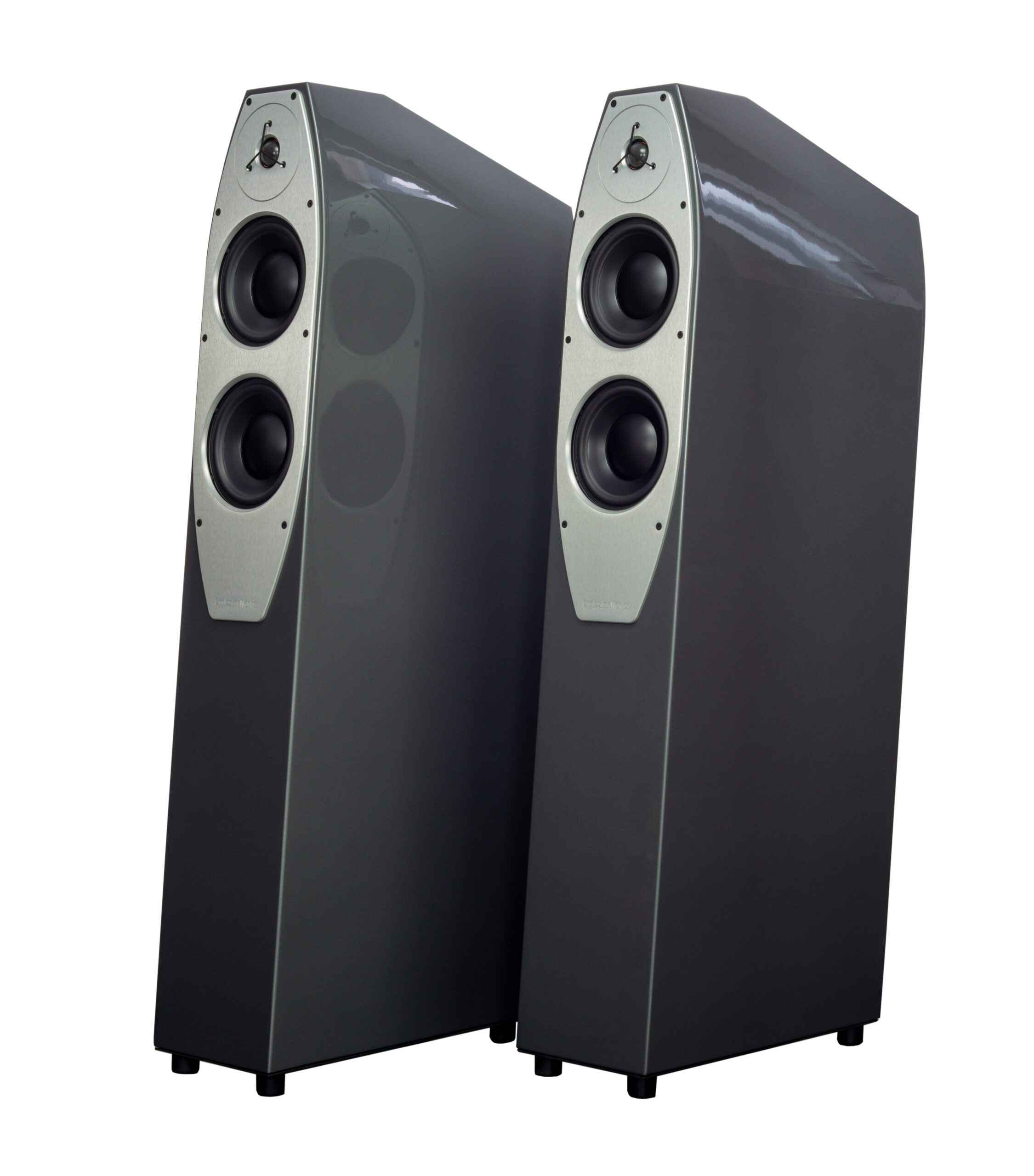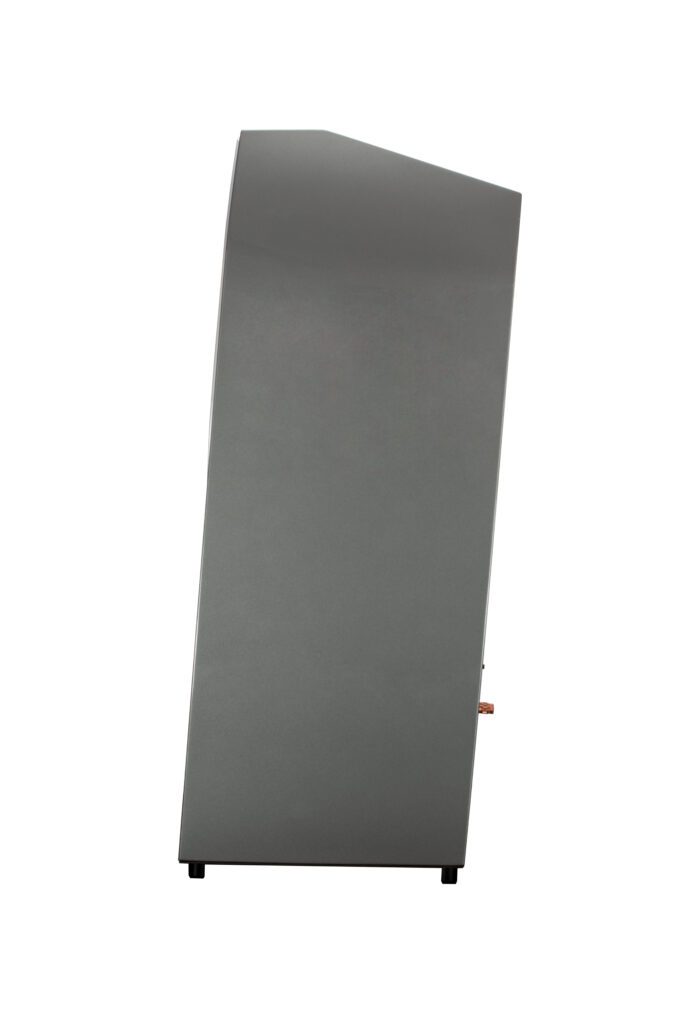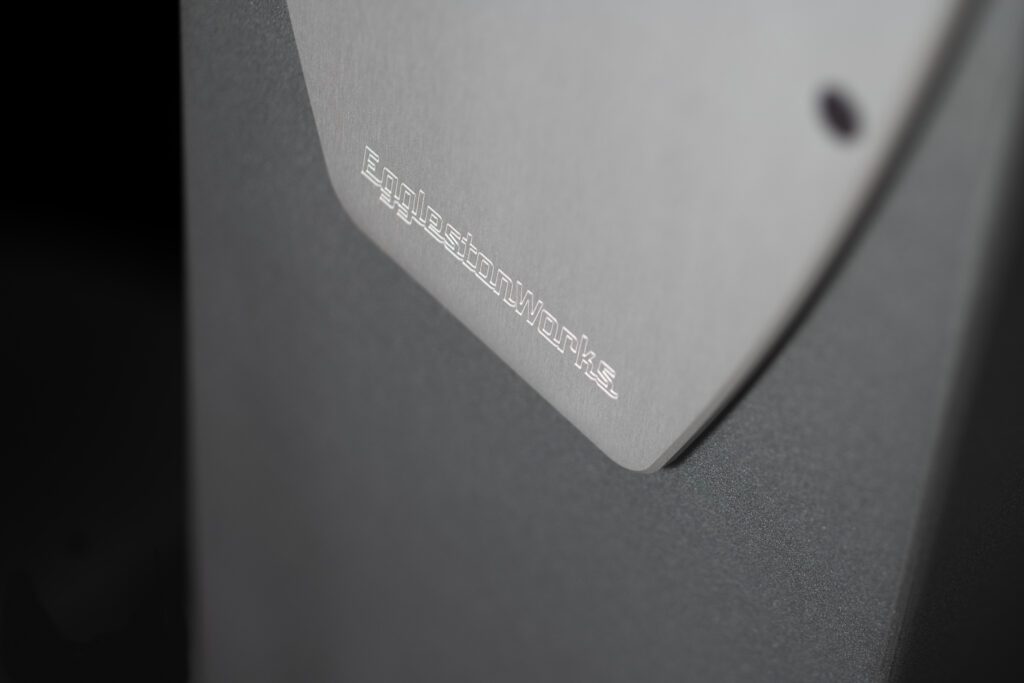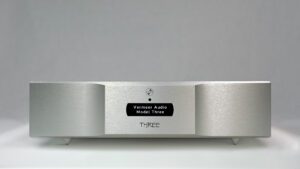
Earlier this year, in issue 205, I reviewed the EgglestonWorks Nico Evo stand-mount loudspeaker. It’s the only stand-mounter in the current EgglestonWorks lineup and at £6,500, including stands, the least expensive model they make. But many of their dealers apparently view the £7,900 Emma Evo as the entry level EgglestonWorks model. I got to wondering about this; is the Nico Evo the odd-man-out? Does the Emma Evo sound somehow more ‘EgglestonWorks’ than the Nico? Is there a presumption that EgglestonWorks customers aren’t really stand-mount people? Only one way to find out, really…
The Emma Evos duly arrived, finished neatly in a silver-grey automotive gloss finish that will probably blend into a wide range of décor styles. Visually, they draw very much on the Nico Evo, a tapering upper cabinet, tiny top plate with a ‘fastback’ downward-sloping rear, and the familiar backward-leaning EgglestonWorks stance. The metal front plate now houses a second bass/mid unit to the Nico’s one, but the actual tweeter and bass/mid drivers are the same for Nico and for Emma. Forever ago, it seems now, I commented that the supplied stand did the Nico Evo few favours, so it’s going to be interesting to see how the floorstander shapes up.

EgglestonWorks have now had stand-mount designs in their range for almost a decade, the Nico Evo being descended from the original Nico, but drawing on lessons learned from the much more expensive Viginti. The Emma Evo took many design elements from the Nico Evo, notably in terms of cabinet construction, the use of the slotted reflex port, and crossover technology. So if we’re looking for a lineage here, Emma is a bigger Nico, rather than Nico being a stand-mount Emma.
It’s not a particularly large loudspeaker, it’s the smallest floorstander EgglestonWorks offers, but neither is it the sort of model you can unobtrusively drop into a small room without a moment’s thought. Clever design means it hides its bulk well, but it’s taller and deeper than you appreciate at first glance, and a good deal heavier than some of its peers at the price. It’s big enough that you are entitled to expect a bit of useful heft in its performance, but it’s not the sort of bruiser that needs some room around it if it isn’t to dominate the space. In short, it shows every sign of being potentially in that Goldilocks zone for a good range of UK-sized rooms. After my positive experience with its smaller sibling, I had high hopes for this one.
Of babies and bathwater
So many makers of highly regarded stand-mount loudspeakers seem to stumble when developing a floorstander. There’s a magic something that so often gets lost in the transition from small and agile, with pinpoint imaging, to scale, weight and generous dynamics. It happens so often, it’s easy to think these are mutually exclusive traits and the best you can do is reach an acceptable compromise, that you’re always going to throw out the ‘disappearing loudspeaker’ baby in the ’scale and dynamics’ bathwater. Partly, perhaps, the challenges of cabinet design are easier to resolve in a smaller enclosure; maybe a full range design exposes the less expensive drivers you can get away with in a bandwidth-limited mini monitor. Or just possibly, what we are hearing so often is the designer’s journey on the big loudspeaker learning curve.
Compromise, what compromise?
Whatever the reason, the Emma Evo doesn’t suffer from this malaise. The baby has been bathed, and remains intact. Similar drive units are used further up the EgglestonWorks food chain, and the port design and crossover technology derives from that used in the £46,000 Viginti. There are tradeoffs, obviously you can’t make an £8,000 loudspeaker the way you make a £46,000 loudspeaker. But EgglestonWorks tell me a lot of that they learned when developing the cabinet for the Viginti has found its way, via the Nico Evo, into the Emma Evo. So I think that, price aside, it’s not particularly helpful to think of the Emma as an entry-level model, and at the price they face some stiff competition so let’s just assess them on their own terms. That’s in keeping with EgglestonWorks’ own expressed philosophy, to let each model be the best it can be, and not to obsess over fitting it into a range at a price point.

As expected, the Emma Evo fills in more of the bottom octave than the Nico Evo, it brings scale and weight commensurate with the bigger cabinet and driver surface area; gratifyingly, though, it concedes very little to the Nico in terms of that disappearing act that small cabinet loudspeakers can achieve.
Lucid
If single-word reviews ever become fashionable, my choice for the EgglestonWorks Emma Evo would be ‘lucid’. But so long as our esteemed editor sees fit to commission a further 1999 words, I’m happy to oblige. What I mean by ‘lucid’ is that the loudspeaker reveals insights deep into the music. There’s clarity and articulation to the presentation; a subtle vagueness has been disposed of, almost as though a light well has been cut into the soundstage, the better to illuminate those denser, innermost regions. To use another visual analogy, it’s as though the loudspeakers found a depth of field you didn’t realise was available.
Take Freddy Kempf, playing Prokofiev’s Second Piano Concerto with the Bergen Philharmonic [BIS, SACD]: I was struck by how much more clearly I could follow the inner workings of the orchestra. When you attend a live performance, the orchestra is arrayed before you and it’s easy enough to follow an instrumental line, or a phrase, pretty much at will. Whereas even very good hi-fi often dissolves into a more impressionistic view, you experience the orchestra as an entity, with only the more prominent lines being available for inspection. The Emmas approached this aspect of the live experience more closely than anything I can recall at this price, with textures and tunefulness well beyond the norm.

And it all works on smaller-scale music, too. Antonio Forcione Live [Naim] and ‘Tarantella’ gave me textures and timbres, intimacy and ebullience; it was very clear how important every member of this small ensemble was to the whole of the musical event here. It does help turn music back into an event – that sense of performance, of a group of people with a common aim, that can often be overlooked, sadly, by systems which don’t resolve as well as the Emmas can. Timing is fundamentally important here, too. ‘Maurizio’s Party’ from the same album: bass notes from the cello were tight and tuneful, solidly underpinning the music; the percussion is fast, but also fully-textured, the shapes of the notes have time to fully develop, they aren’t cut off in the interests of pace or dynamics. Olafur Arnalds ‘This place was a shelter’ from For now I am Winter [Mercury Classics] was full of fine-boned detail, wonderfully contrasting the sonorous piano and ethereal electronica with tight, sinewy playing from the string quartet. This loudspeaker seems to revel in bringing out the full, lush detail and colour in a performance, but not candy-coated – there’s a firm grip on reality here, in all its multi-layered complexity.
For as long as I can remember, I’ve been an advocate of simple, first order crossovers, and the importance of preserving the phase relationships to the benefit of timing, and imaging. Yet here I am, marvelling at a loudspeaker so generously endowed with strengths in so many of the areas I value, and it has a <checks notes> fourth-order crossover. Umm. The crossover technology has trickled down from the much bigger, much more expensive Viginti, so clearly some very useful lessons have been learned.
Along came a spider
If I had a criticism, I would note that the lower treble can on occasion draw attention to itself. It’s not really bright – this is a fabric dome tweeter after all– but now and again there’s a slight fizz at the top of the midrange. I noticed it first on Elbow’s ‘One day like this’ from The Seldom Seen Kid [Geffen] when Guy Garvey’s vocals exhibited more than his customary level of softly silken sibilance, and the occasional slightly acid edge to a note here and there. But here’s the thing: I’d take off both the magnetic grilles and a three-pronged metal ‘spider’ that protects the tweeter. I’d also toed the speakers in much as I usually do. Refitting the spider and adjusting the speaker placement to more or less straight down the room dealt with a lot of this upper midrange artefact. Resting the speaker spikes on AcouPlex discs in place of the metal cups that were provided also paid dividends in terms of the sense of flow and musicality. This is clearly a loudspeaker that rewards a little experimentation in placement and setup. Oh, and I also discovered I was often listening quite unfeasibly loud, perhaps 3 or 4 dB louder than my customary level. I probably owe my neighbours a bottle of something nice.
This in some respects reflects just how clean these loudspeakers are, as other than that slightly ‘hot’ upper midrange, the sort of distortion artefacts that often give cues as to loudness were largely absent. EgglestonWorks don’t make any recommendations as to power handling, the drivers are ‘robust’ and will cope with pretty much anything you throw at them, apparently, and as I found with the Nico Evo, I do think the Emma Evos appreciate a good dollop of quality power. Stanley Clarke’s ‘Bass Folk Song No. 5’ from The Stanley Clarke Band [Heads Up] didn’t have quite the ultimate degree of ‘push’ in the funky bit and there’s perhaps a temptation to turn it up a little more to compensate. Perhaps this is where the compromise is found. If so, it’s a fairly well-chosen one.

The EgglestonWorks Emma Evo has perhaps the most lucid, limpid and insightful presentation of any loudspeaker at its price that I’ve yet heard. Time and again I found myself marvelling at the sheer depth of field this loudspeaker could reproduce. Take Jacques Loussier, ‘Pastorale in C Minor’ from Plays Bach [Telarc]: there’s generous spatial separation between the trio, with solid, stable and convincing images of the players. Instrumental colour is vivid, and consistent, timing tight and precise. There’s an oddity in the way André Arpino plays percussion on this track, consistently just behind the beat for whole sections of the music. It’s quite disconcerting, but clearly intentional; the Emma Evo shows the percussion to be set well back in the soundstage, but that’s not why he’s a little late, he’s very clearly doing this on purpose because he locks-in to other sections of the same track. It’s these sorts of insights that elevate the Emmas above the competition.
So where the Nico Evo exemplified the best in a smallish, standmounting loudspeaker – coherence, speed, imaging, invisibility – the Emma Evo takes those qualities and adds scale, weight and another layer of colour and texture. You still get all the pace, coherence and clarity, the limpid, lucid vision into the heart of the music, but you also get a bit more of that heart. It’s pretty clear that if there’s a ‘house sound,’ both the Emma and the Nico Evos conform to it. The Emma Evo isn’t a large loudspeaker, though neither is it small, but because of the sheer levels of insight and detail there’s no real sense that you’re being short-changed on large-scale performances, and small-scale stuff just invites you right in to share in the intimate, immersive music-making experience. They respond to a little tweaking, and they’ll reward quality in the upstream elements of your system, they’re just so very communicative of what’s going on. They are proof that in moving from stand-mount to floorstander you don’t have to compromise on the strengths of a superlative small loudspeaker, you can just add other qualities on top if you do it right.
Technical specifications
- Type Two-way floorstanding, reflex-loaded loudspeaker with rearward-facing slotted port
- Driver complement 1× 1” fabric dome tweeter, 2× 6” poly composite mid/woofer
- Power handling no upper limit specified
- Crossover frequency 2.1kHz
- Crossover type Single-wired, low pass and high pass crossover 4th order Linkwitz Riley Acoustic slope via a 2nd order electrical circuit
- Frequency response (in-room, typical) 30Hz-24kHz +/-3dB
- Impedance 6 Ohms nominal, 4.1 Ohms minimum at 150Hz
- Sensitivity 88dB for 1 Watt at 1 Metre
- Dimensions (H×W×D) 1090 × 190 × 400mm
- Weight 31 Kg each
- Finishes white, silver or black high gloss finish. Any automotive paint colour by arrangement (extra cost option)
- Price £7,900/pair
Manufacturer
EgglestonWorks
UK Distributor
Auden Distribution
By Steve Dickinson
More articles from this authorRead Next From Review
See all
PrimaLuna EVO 100 phono preamplifier
- Apr 22, 2024

Reiki Audio SuperSwitch Master Pro + Servant Pro
- Mar 27, 2024

Melco Audio N1-S38 music server
- Mar 27, 2024











